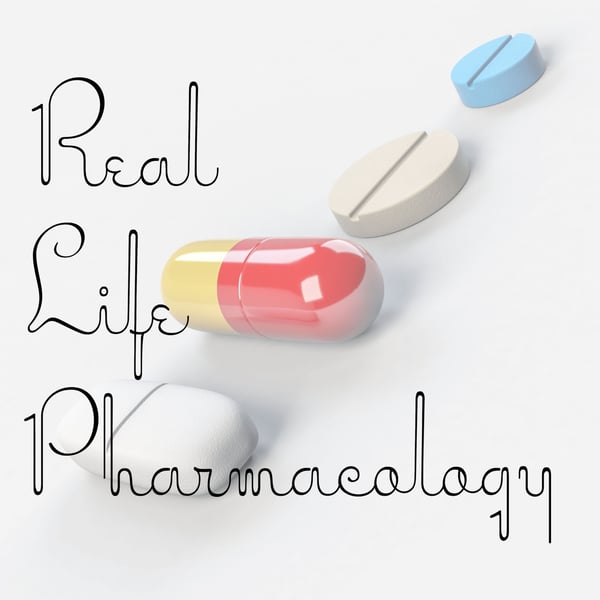Hydroxyzine Pharmacology
Real Life Pharmacology - Pharmacology Education for Health Care Professionals
Eric Christianson, PharmD; Pharmacology Expert and Clinical Pharmacist
5 • 716 Ratings
🗓️ 6 May 2021
⏱️ 13 minutes
🧾️ Download transcript
Summary
Interactions: Due to hydroxyzine’s pharmacology and mechanism of action, it can exacerbate or worsen gastroparesis by decreasing smooth muscle contraction in the GI tract, and has similar effects on benign prostatic hyperplasia by worsening urinary retention. Hydroxyzine is metabolized into its active drug, cetirizine, by CYP3A4 and CYP3A5[3]. As such, hydroxyzine’s efficacy can be increased with concomitant use of rifampin, carbamazepine, St. John’s Wort; and its efficacy can be decreased with concomitant use of certain azole antifungals, verapamil or diltiazem, or grapefruit juice. The anticholinergic effects can also be compounded when taken with other anticholinergic drugs and can decrease the efficacy of certain dementia medications, like clonidine. Although uncommon, the risk of QTC prolongation, and Torsades de Pointes, can be increased when taken with potassium channel blocking agents like amiodarone or sotalol, or other agents like certain antibiotics and antipsychotics[4][5].
PK/PD & toxicity: Hydroxyzine has an onset of action between 15-60 minutes and a duration of action between 4-6 hours[3]. The half-life of hydroxyzine varies with age. On average, it is 7.1 hours in children, 20 hours in adults[6], and 29 hours in the elderly, and should be dosed appropriately[7]. Its volume of distribution is 16±3 L/kg with high concentrations found in the skin than in plasma[3]. Its clearance is 31.1±11.1 mL/min/kg in children and 9.8±3.3 mL/min/kg in adults. The active drug of hydroxyzine is excreted around 70% unchanged in the urine[6]. Overdoses can be characterized by sedation, but can also cause nausea, vomiting, and seizures. General supportive care of the symptoms is needed for treatment. Vomiting should be induced if it has not occurred. Immediate gastric lavage is also recommended[8].
Show notes written by Chong Yol G Kim, PharmD Student
References
[1] Fifer EK. Drugs Used to Treat Ocular and Nasal Congestion Disorders. In: Roche VF, Zito SW, Lemke TL, Williams DA. Eds. Foye’s Principles of Medicinal Chemistry 8e. Lippincott Williams & Wilkins; Accessed May 15, 2021.
[2] Katzung BG. Histamine, Serotonin, & the Ergot Alkaloids. In: Katzung BG, Vanderah TW. eds. Basic & Clinical Pharmacology, 15e. McGraw-Hill; Accessed May 15, 2021.
[3] Altamura AC, Moliterno D, Paletta S, Maffini M, Mauri MC, Bareggi S: Understanding the pharmacokinetics of anxiolytic drugs. Expert Opin Drug Metab Toxicol. 2013 Apr;9(4):423-40. doi: 10.1517/17425255.2013.759209. Epub 2013 Jan 21.
[4] Schlit AF, Delaunois A, Colomar A, Claudio B, Cariolato L, Boev R, Valentin JP, Peters C, Sloan VS, Bentz JWG: Risk of QT prolongation and torsade de pointes associated with exposure to hydroxyzine: re-evaluation of an established drug. Pharmacol Res Perspect. 2017 Apr 21;5(3):e00309. doi: 10.1002/prp2.309. eCollection 2017 Jun.
[5] Nachimuthu S, Assar MD, Schussler JM. Drug-induced QT interval prolongation: mechanisms and clinical management. Ther Adv Drug Saf. 2012;3(5):241-253. doi:10.1177/2042098612454283
[6] Paton DM,
Transcript
Click on a timestamp to play from that location
| 0:00.0 | Hey all, welcome back to the Real Life Pharmacology podcast. I'm your host, pharmacist Eric Christensen. |
| 0:06.1 | Thank you so much for listening today. As always, head to Real Life Pharmacology.com and check out |
| 0:12.9 | the free 31 page PDF I have on the top 200 drugs. It's a great little resource for anybody |
| 0:20.4 | looking to brush up on their clinical skills, |
| 0:23.6 | as well as a prep tool if you're looking at board exams or pharmacology exams in school there. |
| 0:29.5 | So go take advantage of that. Let's get into the drug of the day today, and that is hydroxazine. |
| 0:36.8 | Brand name of this medication that I've seen thrown around |
| 0:40.0 | most often is Adirax or Vistoral. And mechanistically, hydroxazine can cause a bunch of different |
| 0:51.1 | effects. It's primarily categorized as an antihistamine in that it blocks H1 receptors. |
| 1:00.2 | So remember H2 receptors are more in the gut relating to acid secretion and things like that. |
| 1:05.8 | So that's like your Fomododidine, for example. |
| 1:09.9 | Histamine 1 blockers give you more of the anti-hitching, anticholinergic, |
| 1:16.9 | antihistamine, you know, allergy relieving, those type of effects with that. |
| 1:24.0 | So that kind of feeds into uses and what this medication is used for. |
| 1:31.1 | So probably in clinical practice, I see it used for two or three different things on a pretty |
| 1:39.3 | regular basis. |
| 1:41.0 | I would say the most common two are itching and anxiety. |
| 1:47.6 | And it can be used on an as-needed basis, and I'll touch on that a little bit in the |
| 1:52.0 | kinetics section. |
| 1:54.2 | But for straight allergies like post-nasal drip and symptoms like that, |
| 2:01.8 | you're typically not going to see hydroxazine used for that, |
| 2:05.7 | even though technically it is classified within the same category as a diphenhydramine. |
... |
Please login to see the full transcript.
Disclaimer: The podcast and artwork embedded on this page are from Eric Christianson, PharmD; Pharmacology Expert and Clinical Pharmacist, and are the property of its owner and not affiliated with or endorsed by Tapesearch.
Generated transcripts are the property of Eric Christianson, PharmD; Pharmacology Expert and Clinical Pharmacist and are distributed freely under the Fair Use doctrine. Transcripts generated by Tapesearch are not guaranteed to be accurate.
Copyright © Tapesearch 2025.

